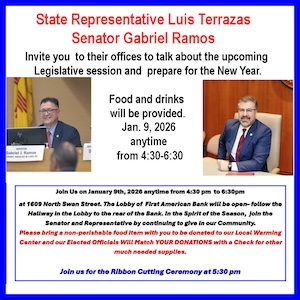By Lynn Janes
The Gila National Forest celebrated its 100 year centennial during the week of May 29, 2024. On May 31, 2024, the celebration had a speaker series and one had been Wilderness Explorations.
The speaker series could be attended in person or virtual. People from all over the United States and Canada attended the virtual. Ray Trejo opened the presentation. He works with the New Mexico Wildlife Federation and lives in Deming. He said he had been fortunate that his family had brought him to the Gila growing up. He had spent many times hunting, fishing and camping. He remembered as a kid catching the iconic Gila Trout. Much of that time had been spent at Turkey Creek.
Curt Meine a conservative biologist from Wisconsin and the biographer of a book on Aldo Leopold. He also serves as a senior fellow of the Aldo Leopold Wilderness Foundation and many other organizations.
"When you hear the word wilderness what do you think? What is the first thing that comes to mind?" Many different thoughts came from the attendees. Some of the words people came up with, sacred, complexity and solitude. One that came up several times, lack of humans.
Meine said he wanted to honor the ancestors and elders and honor their voices. He had videos of several people that had deep ties to New Mexico to give their views. The videos had come from a documentary done thirteen years ago called Green Fire. Scott Momaday with Jimenez Pueblo; Sid Goodloe, a rancher; steward of the land Dave Foreman; and Estella Leopold, the last surviving child of Aldo Leopold. These all had been very diverse people.
In the very early 1900s Leopold came to the area as a young forester. His job as assistant forester had been to prepare inspection reports that required him to pack into the wilderness by horseback. He was able to get to know all the national forests of the southwest.
Leopold met with Arthur Carhart in 1919. They came together to discuss the protection of the national forests and what that would look like. In 1921 Leopold published in the Journal of Forestry, The Role of Wilderness in Forest Recreation Policy. Wilderness would be a continuous stretch of property left in its natural state open to hunting and fishing and big enough to absorb a two-week pack trip. He wrote of the Gila and its highest use demanding its preservation.
In the spring of 1922 Leopold came to Silver City and prepared his inspection report for the Gila. In that spring it had been a bad fire season and he spent most of his time overseeing fire crews. He prepared his report in August and part of the report he had proposed wilderness areas. It would be a formal proposal for a limited land use area. This idea came in part due to the nationwide push to have many good roads. This would be the beginning of the automobile and the need to provide roads everywhere.
On June 3, 1924, Frank Pooler, regional forester, signed the document to make the Gila a wilderness area. Leopold continued his advocacy after leaving the southwest and returned to the Gila periodically. Bob Marshall, in 1930 took over and expanded it to a national effort.
Through the years Leopold's advocacy expanded to not preserving for just hunting, fishing and recreation but research and land health. His legacy has been recognized with the 1964 Wilderness Act.
Meine ended the presentation with some thoughts. "One hundred years ago a quiet bureaucratic action was taken here to address a perceived threat, the incursion of roads. There are many words to share about the wilderness, what will it mean in another one hundred years. How will that word echo off the canyons and flow through the rivers"
Priscilla Solis Ybarra, professor in the department of English at North Texas University, writes and teaches about Mexican American culture and dwelling well with the earth. Her parents had been immigrants and she said she worked to honor her ancestors.
She spoke on the debate on wilderness and wanted to give a little more on that debate. She read from a book she wrote on the idea of environmentalism. She didn't feel like she had a place and felt alien. She felt apart and did not fit in. Nothing told the story of her Mexican American heritage. "The separation of humans and nature did not fit with my culture's relation with nature."
Ybarra said the Mexican American culture would refer to the wilderness as stolen land.
She had slides from the Carson National Forest in October of 1966 and some activists. This went back to the Spanish Land Grant of 1806. La Alianza wanted the land restored. She recounted the story and consequences. None of this has been taught in school. "Many contributions to the United States history of the Hispanic, Black, Indigenous, Mexican American, Asian American still get left out."
She gave an example of something not taught. Estella Bergere Leopold, the wife of Aldo Leopold, was a Mexican American. They married in 1912. She had been born in Santa Fe in 1890 and Ybarra provided a history of her lineage that went back to the Spanish in 1716. "Why is her background hidden?" None of the conservation would have been possible without her and her family.
Enriqueta Vasquez, a Chicana feminist writer and part of the Chicana movement, urged the movement to come back to its true selves, to the indigenous family ties. She found it hard to understand the concept of ownership and possession of land. Ybarra read quotes from Vasquez's many writings. She spoke about Tijerina and the land grants and Leopold's efforts to protect the land. "Wilderness to the Mexican American depends on who you ask."
Leeanna Torres, native daughter of the American southwest and a Gila Trout biologist, worked in the Gila Trout recovery efforts 2003-2008. She has been an environmental professional since 2001 and written for many publications.
Torres recounted her experiences in the Gila in which she wrote an anthology called Gila as Querencia. She recounted the first experience on horseback in the Gila to do fish surveys. It had happened in August of 2004, and everything had been in bloom. She had never been there before, and work had brought her there. She had finally earned her way to a Gila trip. "I was a girl among men traveling deep into the wilderness to conduct fish surveys." Despite being a native of New Mexico, she had never set foot in the Gila until work sent her there. As a kid her family never had gone camping. "Quiet Chicana girls don't work as fishery biologists." The Gila landscape revealed more to her about herself than any church or IQ test. She described the Gila as a rugged diverse landscape of the southwest. She went over how that time had defined her and how it still impacts her.
Torres said Leopold set the wheels in motion to protect the Gila as a wilderness. The origins of what he did had been his work. It introduced him to the landscape. "My work introduced me to the landscape."
She had graduated from University of New Mexico with a bachelors degree in biology. It had taken her six months to find a job with the US Fish and Wildlife. She started on long days working on the muddy rivers of the Rio Grande and Pecos. After three years she had been invited on a Gila Trip. It had taken time to prove she could do it. It took weeks to pack in and out of the brutal rugged wilderness. They had started at the Heart Bar Ranch and rode in twenty miles to White Creek, the native home waters of the Gila Trout.
"Querencia, loosely defined in my New Mexican culture, means that which gives us a sense of place, that which anchors us to the ground. It is more than a concept."
She had just been a technician, not the head of the research crew and one of two females on the trip. She said she had been willing and able to work. "It was brutal but a privilege. Working in the Gila had been about the fish but had never been about the fish." Gila Trout has been the rarest species in the United States and because of recovery efforts have seen an increase. In 1967 it had been listed as endangered, now in 2006 it has been downlisted to threatened due to successful restoration.
"Querencia, a deep love of place or belonging to a place." A popular term in the Spanish language used to express a deeply loved place or people. Although a Spanish word, the idea is universal.
Querencia a place of your deepest identity. It had been many years since her work in the Gila but, "It remains my Querencia." She said she returned to the Gila in 2022 not as a fish biologist but as a mother. She thought about the people that taught her about the Gila, the mules and horses on the trip.
"The American southwest is my birthplace. It is the landscape of my ancestors and yet I never deny or look away from the brutalities and injustices of the past."
Torres read from a book, True West, the book says we live among myths and a myth-making species. It referred to how Hollywood had made us revere the western cowboy culture, rugged individualism, and open spaces. The book goes on to say the west is far more complicated with a history further back than the cowboy.
Torres read some of her old field notes from her trip into the Gila many years ago. She also recounted her trip in 2022 with her son to the Gila. "I still ask what it means to recover a species, what does it mean to protect a place and how do places become important to us."











